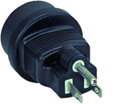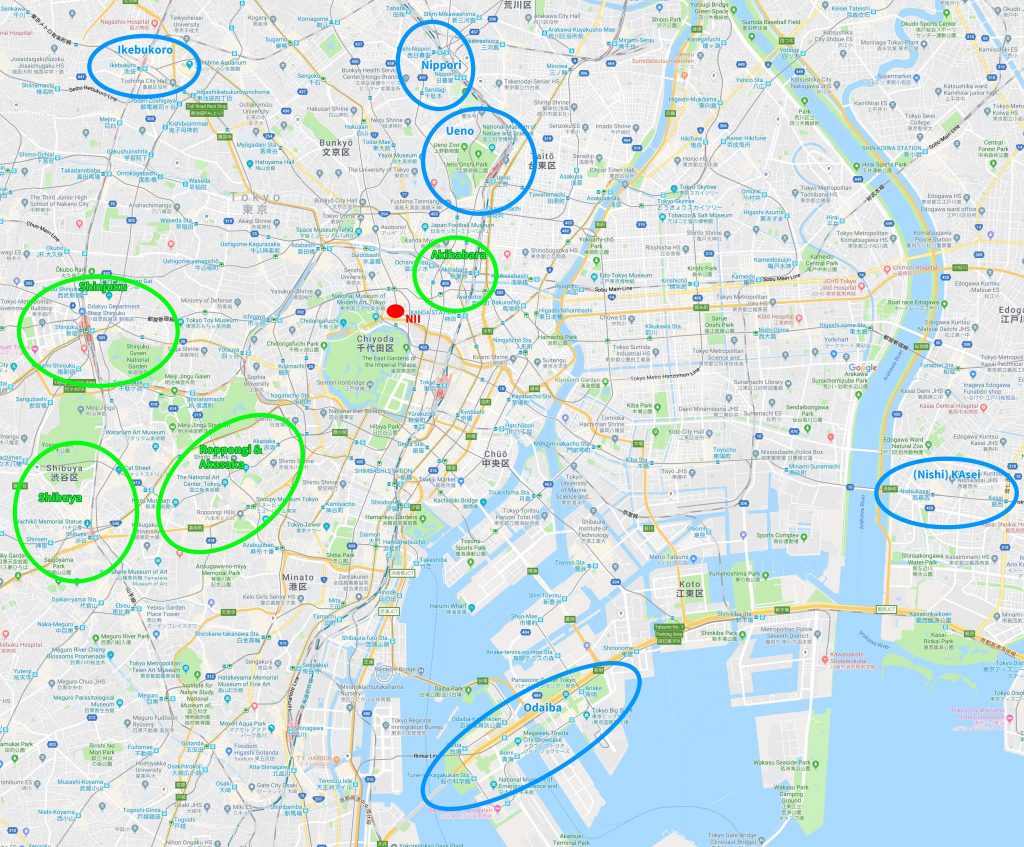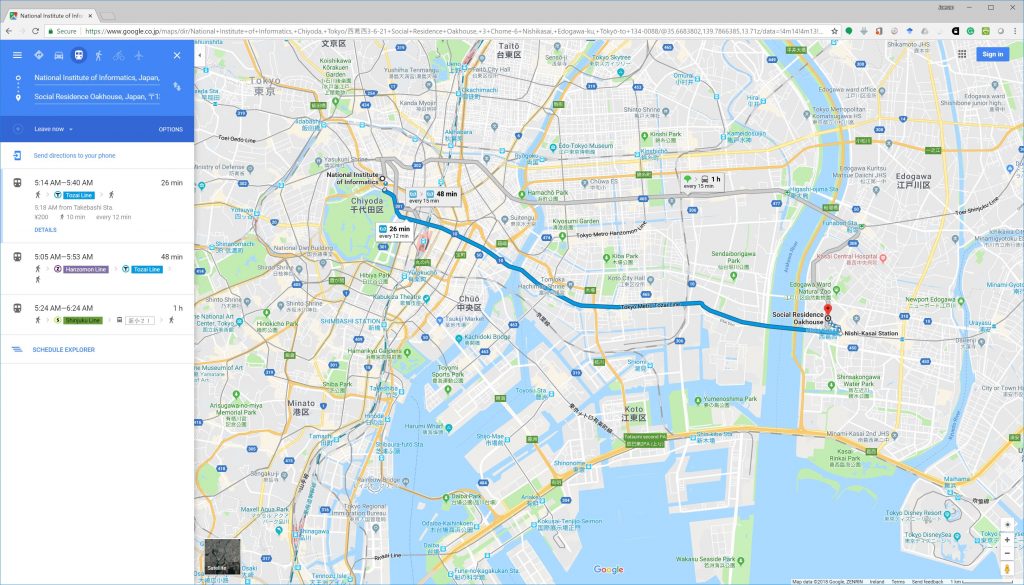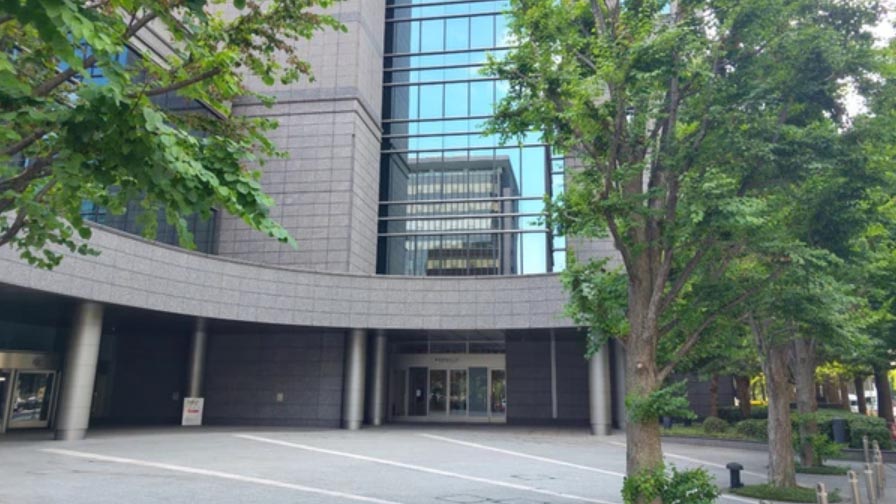This page provides information for students who are interested in working at the National Institute of Informatics (NII) in Tokyo, Japan. This page focuses on students who are already accepted as internship students, or who want to get an idea what work and life in Tokyo will be like. If you are interested in applying for an internship as a student at TCD or ADAPT, talk to your supervisor and apply for the Earrach Sakura Award. If you are from another university, find out if your university has a memorandum of understanding (MoU) with the NII. If your university has a MoU with the NII, find out who the coordinator at your university is, and contact the coordinator.
Impressions
To get an idea what will expect you in Japan, have a look at these photos:
https://www.dropbox.com/sh/nivwnoqnhirkuxw/AADlxO3pfCXyAwkXP2YR02U-a?dl=0
 Also read the internship report of Felix (page 50, in German) and other reports (English) of students of the University of Konstanz who did an internship at the NII (scroll to the bottom of the page).
Also read the internship report of Felix (page 50, in German) and other reports (English) of students of the University of Konstanz who did an internship at the NII (scroll to the bottom of the page).
Pre-Arrival VISA
To come to Japan, the following steps are necessary.
- Finalize your travel plans with your supervisor, i.e. send him the following details as soon as possible (even if you told him some of the details already – please send a separate email with all the details)
- The expected arrival date: e.g. “I will arrive between June 1 and June 6, preferably on June 5 (the final date depends on when I get a cheap flight)”
- Te expected departure date: e.g. “I will depart between August 29 and September 2, preferably on August 30”.
- Full name:
- Nationality:
- Gender:
- Day of birth:
- Address:
- Email:
- Phone:
- Affiliation: Current university including Department name
- Affiliation Address:
- Student ID:
- Name of the dean at home university:
- Status: e.g. Master student
- Enrolled since: the year/month since when you are enrolled as e.g. Master student
- Expected date of completion
- Major: e.g. Computer Science
- Research Topic During Internship:
- Name of your supervisor at NII:
- Attachments
- CV
- Photo (high resolution; colour), the photo is used to create your ID card at NII
- If you apply for the official NII internship: Letter of recommendation (you need a 1-page letter of recommendation from a professor at your home university)
- If you are a EU citizen you can stay up to 90 days in Japan without a Visa (actually you can extend by another 90 days (180 days in total) when in Japan.
- If you are not from the EU or plan to stay more than 90 days, apply for a Certificate of Eligibility (COE), which is the prerequisite to apply for a visa.
- Your supervisor will share a folder on Onedrive with you that contains detailed instructions
- You fill the form, collect the required documents and store all documents in Onedrive.
- Your supervisor will forward the documents to the NII, or tells you to which email address to send your documents.
- The NII will apply for the COE in your name at the consulate in Tokyo. Once you sent your documents to your supervisor it might take around a week before the NII submits the documents.
- Wait for the COE to arrive at the NII (usually 3-4 weeks)
- The NII will send the COE to your mailing address
- Once you have the COE, make an appointment with your embassy and apply for a cultural-activities-visa (processing the application takes around 5 working days, at least in Germany)
- When you received your visa, book a flight and accommodation.
- Once you booked a flight, let your supervisor know the details (flight times, flight number)
Electricity
Shops often sell 3-pin electricity adapters for Japan. They look like this:

However, many sockets in Japan look like this:

They only have two pins, i.e. the adapter above does not fit. We recommend buying one or two 3-pin adapters because at the NII you usually can use them (and the 3-pin adapters are more stable than 2-pin adapters). Otherwise, we recommend to buy several 2-pin adapters that look like this:

You may also buy adapters such as the following one, but they are usually not very robust.

Mobile Phones and SIM Cards
todo…
Accommodation
Compared to Germany, housing in Japan is of lower quality. Rooms are smaller, there are often single-glass windows, and walls tend to be thin. Compared to Ireland, housing quality in Japan is around the same. For a private room in a shared house (you share kitchen and bathroom) you may pay somewhat between 50,000 and 90,000 YEN per month, depending on the location and quality of the house. For a small apartment/studio (maybe 20-30m²), you would probably pay something between 90,000-150,000 YEN. Typically, monthly rent is cheaper compared to weekly rent. For instance, if you rent a small apartment at Bamboo House, two weeks are almost as expensive as if you rent for a month.
List of housing organizations
There is a number of housing organizations. So far, we have made good experiences with Oakhouse, Sakura, and Bamboo House but that does not mean the others are not good (we just didn’t yet try them).
| Organization | Experience |
|---|---|
| http://tokyo.craigslist.jp/ | Be aware of scammers (not only in Japan but generally on Craigslist). Personally, I wouldn’t recommend to book and pay anything in advance over Craigslist. If you are already in Tokyo and can have a look at the room, Craigslist might be a good option. |
| https://kshouse.jp/tokyo-e/index.html | |
| http://www.chouse-tokyo.jp/en/ | |
| http://share-style.net/sharehouse/ | |
| http://www.social-apartment.com | |
| http://www.tokyoroomfinder.com/ | |
| http://www.tokyo-information.com/eng/g-house-ichiran.html | |
| https://tokyosharehouse.com/eng/ | |
| http://www.bamboo-house.com/searchavailability.php?availability=1 | We stayed at House Fujimi. Quiet house, residential area, typical Japanese style. Metro connection is not ideal but ok. The quality of the rooms differs a lot. Some are really nice, others are not. |
| http://www.sharedesign.co.jp/en/article.php?articleid=113 | |
| http://www.oakhouse.jp/eng/ | Many of us stayed in the Oakhouse Nishi Kasai. This social residence (60+ people) has a comparatively high standard with a really big and nice kitchen and library. However, it is rather far to commute to the NII and there is not much going on in that area. Typically, there are around 50:50 Japanese people and foreigners in Oakhouses.
Oakhouse, in general, comes with rather high management costs (~30.000 YEN) and the disadvantage that you have to buy blankets and sheets for the bed (or bring it from home). This may lead to an extra of up to 40.000 Yen (~ 360 Euro) in comparison to other housing companies with lower initial costs (e.g. Sakura House: 5.000 YEN) and free linen. |
| https://www.borderless-house.com | |
| https://www.homestay.com (for staying with a guest family) | |
| http://www.sakura-house.com/en | Probably the most popular organization for shared houses. Some of us stayed with them and the overall experience was good. The rooms are often not as good as Oakouses in terms of quality, but often the locations are more central. The disadvantage is that no Japanese people are allowed. If you want to connect with Japanese and their culture, living with some of them can be very helpful to get in contact. Joeran once stayed in this house – the location is perfect (8 minutes walking from Shibuya Station, direct metro to NII) and relatively quiet. However, the rooms are of a low standard, and the walls in the house are thin, so it may be quite noisy. Anyway, the house is worth to consider if you want to experience Tokyo. |
| http://airbnb.com | Lot’s of different accommodation, but rather expensive. Good for short stays (a week or so). |
| http://www.t-tower-guesthouse.com/ | Recently build guest house in the nice Takadanobaba neighbourhood (direct train connection to NII, 30min by bike to NII). |
Oakhouse and other companies offer to provide you with a beddings package (incl. cover, sheet, etc). At least for Oakhouse, this is highly overpriced (around 90€). Consider just going to a nearby Donkijote (a Japanese company with large multi-purpose shopping stores) or any other store and buy it yourself there, or bring it from your home country.
Tokyo Map / Areas to Live
When looking for a place to live in Tokyo, consider the following:
- Safety: As far as we know, there is not a single district in Tokyo where you would have to be seriously worried about safety. Maybe Roppongi with its prostitutes and some pimps is not the very best place at night for women but probably even Roppongi is safer than the average district in an average European capital.
- Time to commute: If possible, try to find a place from which you don’t need hours to get to your workplace. The NII is located between Takebashi Station and Jimbocho Station. Hence, living at a station that directly connects to Takebashi or Jimbocho is advisable (do not pick a place that requires two or more changes of metro/bus lines).
- Distance to next metro: Pick a place that is not more than 10 minutes walking from a metro station. This makes you much more flexible to go where ever you want to go to.
- Experience the “real” Tokyo: Tokyo’s “hotspots” are Shibuya, Roppongi, Shinjuku and Akihabara (see map). If you want to go out at night, or just have the real crowded Tokyo feeling, try to find a flat close to one of those hot-spots. Keep also in mind that Tokyo’s public transport shuts down around midnight. Hence, if you like to go out at night, you should look for a place in walking distance to one of those hotspots. Personally, I (i.e. Joeran) would recommend staying in a central area. You will be able to experience Tokyo much more intensive as when staying e.g. in Oakhouse / Nishi Kasai. Other popular areas to live are Ikebukoro, Nippori, and Ueno (Odaiba is also really nice but far from the NII and usually it is difficult to get accommodation on Odaiba). These areas do not have as much night live as Shibuya etc. However, they are very nice and usually a bit chepaer.

- Distance to the next park: Especially summers are really hot in Tokyo. Staying near a park or the ocean is a plus.
- Total costs: Keep in mind that commuting costs quite a bit of money. Riding from Nishi Kasai Oakhouse to NII, costs around 200 YEN, one way. That adds up easily to 70 Euros per months. If you find a place in walking or cycling distance to NII, this would save you some money. However, a place close to the NII is more central in Tokyo so you will spend the saved amount probably for the increased price of your room (or the room will be smaller).
- In short: A place in or around any of the circled area is probably a good choice (Nishi Kasei not so much)
This is an alternative map, found on http://nyu.timbyrnes.net/nii-internships/ (keep in mind, it may be possible to find affordable accommodation in the “expensive” areas if you compromise on room size and quality).

When to look for accommodation?
Most housing organizations have a one-month cancellation period. This means, when you are looking for an accommodation it is rather unlikely that you can book something more than one month in advance because the organizations won’t know already who is moving out in e.g. 2 months. So, often you can rent a flat short time, i.e. 2-4 weeks in advance. Of course, you can (and should) try anyway to find something as soon as possible. In general, finding an accommodation in Tokyo is rather easy at least if you are willing to either pay a lot or commute for 45+ minutes. Sometimes, organizations like Oakhouse have “early booking” discounts.
Transportation
Public Transport
In Tokyo, there are different types of public transport: Metro, JR trains, and buses. Metro and JR trains are basically the same (we will just use the term “metro” in the remainder to refer to both, metro and JR trains).
| Metro | Bus | Taxi | |
|---|---|---|---|
| Costs | Typically between 100 and 400 YEN per ride, depending on the distance | Flat fee (230 YEN) | Really expensive, especially during the night. |
| Hours | From around 5am until around 11:45pm (yes, there is no public transport during the night!) | Same as metro. | 24h |
| Ease of use | Easy, all signs in the metros and metro stations are bi-lingual (English and Japanese), and there are usually lots of signs | Not that easy. If you are lucky, the bus line has a number. If you are not lucky the bus line just has some Japanese characters, which might make it difficult to find the right bus (especially if there are different lines stopping at one station). Also, while Metros usually have English signs and displays showing the name of the next station, not all buses have. Tipp: Use Google Maps and compare the Kanji letters shown in the display of the bus with those shown on your phone. Or you can always ask the bus driver, they are usually very helpful – as most Japanese people. | Easy, just show them Google Maps with your destination. |
For metro, you can buy individual tickets in every station and pay in cash or with Pasmo card. For buses, you can pay directly in the bus (usually, you don’t get change) or Pasmo card. A “Pasmo” card is a small plastic card with a chip, on which you can top-up money, and then, whenever you enter (and leave) the metro or bus, you hold your Pasmo card against a card reader, and the fare is automatically deducted from your Pasmo balance. There are also 1-day, 2-day and 3-day pass, but they are rather expensive. There is no “normal” monthly ticket that allows you to take all metro lines for one month, but there are commuter passes being valid for riding between your house and your workplace. While you can buy Pasmo cards almost in every Metro station, commuter passes are only available at the big stations as far as we know. Commuter passes are available for 1, 3, or 6 months – the longer the period, the higher the discount. For instance, travelling from Shibuya to NII 20 days a month costs around 8.000 YEN if you pay by ride. A 1-month pass costs around 7.100 YEN.
Google Maps has all the schedules of the buses, metro and trains. So, navigating around Tokyo is in general pretty easy if you have internet access. For instance:
https://www.google.co.jp/maps/dir/National+Institute+of+Informatics,+Chiyoda,+Tokyo/%E8%A5%BF%E8%91%9B%E8%A5%BF3-6-21+Social+Residence+Oakhouse,+3+Chome-6+Nishikasai,+Edogawa-ku,+T%C5%8Dky%C5%8D-to+134-0088/@35.6798502,139.773479,13z/data=!4m14!4m13!1m5!1m1!1s0x60188c11e52a7af7:0x59be01a56f0cf10e!2m2!1d139.7581921!2d35.6924336!1m5!1m1!1s0x601887dfd9804ccf:0x1ec02d4afa045900!2m2!1d139.8564931!2d35.6673209!3e3

Keep in mind that changing metros may be time-consuming. Most metro stations are really huge and getting from one line to another (even if it’s in the same station) may easily take 5 minutes or more. At big stations (e.g. Otemachi or Shinjuku), you may easily spend 10 or 15 minutes for changing lines, especially if you don’t know exactly where the lines are.
Cycling
Even though Tokyo is not per se a paradise for cyclists, diving into the traffic on your own two wheels offers many advantages and is usually quite safe. Car drivers take a lot of care and cyclists are basically allowed to drive everywhere they want, on the road or walking paths. Clear advantages if you buy a bike
- No bothering with metro rush hours anymore (which will annoy you from the very first day)
- Saving a lot of money for metro tickets (e.g. even for the cheapest one-way of 170 Yen, if you only go to work and nowhere else the saving is 7650 Yen per month)
- Being independent of the metro schedule, especially during the night and morning hours, if you plan on going out
- You get to see so much more from Tokyo not spending all your commuting time in the underground
- You’ll stay in form
Still, there are some disadvantages
- Parking your bike in Tokyo is annoying as you can’t just leave your bike just where you want. Well, you shouldn’t. Still, you normally just get warnings and you will never get fined
- You won’t find a reasonably-priced bike bigger than 26-27″ in Tokyo
- Bikes are registered. This leads to the fact that no-one will steal your bike but depending on where you buy it, you’ll have to register it first before you can ride it.
Where to get a bike?
Depending on the type of bike you get (it will probably be a typical “Mamacharie”), not all bike stores do have the tools to maintain them. Near NII there is a good bike store where they do Mamacharies with a maintenance service for around 820 Yen. When you leave Japan, you can sell your bike via Craigslist, mostly this works within 1 or 2 days, probably even without a loss of money on your side. Still, remember that you have to newly register the bike for the new owner.
There are some places with good second-hand bike offerings in Tokyo:
Recycle Garden Yoyogi
This is something like a 100 Yen store for used objects. If you are lucky, they have 2 or 3 affordable bikes in a pretty good condition for < 10.000 Yen. It is located north of Yoyogi Park, so you could easily combine it with a park stay and have a glimpse on their stock. If you wish, they’ll register your bike for an additional fee of 500 Yen.
Address: 3-38-10 Yoyogi, Shibuya-ku, Tokyo
Musashino-shi Silver Jinzai Recycling Center
This is the only true address to get your refurbished, super-conditioned and affordable companion on two wheels. This recycling centre opens for three days per months at 11 am and sells there bikes in a first-come-first-served way. You better show up early, as there will be a lot of people and if they are first, they’ll get to choose their bike first, too. They are normally sold out on the first day very quickly but will have another bunch of bikes for the second and third day too. Most people show up on the first day, so you should think of going there on the second or third day. Bikes are from 6700-15500 Yen.
As soon as you’ve chosen your bike, you’ll directly get to pay it and they’ll register it for you. The whole procedure will take up to 1,5 hours, but afterwards, you can directly leave on your new bike and make your way home through the city jungle.
Address: 3-5-16 Nakamachi, Musashino-shi
Check their webpage for the dates each month: http://www.sjc.ne.jp/suginami/14dokuji/risaikuru/risaikuru.html
Register a Bike
If you buy a bike you need to register it. Read here for more details: https://blog.gaijinpot.com/registering-used-bicycle-japan/
Rental Cars
To rent a car, you need a translation of your driver’s licence – an international driver’s licence is not enough! In Tokyo, there are several offices where you can apply for such a translation. For Germans, the process is easy. You just go there, fill some forms, pay 3,000 Yen or so, and on the next day you can pick up your translation (there is no guarantee that you get it within 24 hours, it might also take longer). For other nationalities, the process might take longer (up to two weeks). The driver license is translated by JAF (Japanese ADAC). See JAF’s International Service Counters for details: http://www.jaf.or.jp/inter/entrust/index_e.htm
I rented a car on Okinawa via the German website billiger-mietwagen.de and costs were quite reasonable (30 Euros per day). The condition of the car was fine and driving in Japan is easy (however, you need to keep in mind to drive on the left side). Cars can be rented for even less money from the private lender website, but Japanese language skills are highly recommended: http://cafore.jp/
Working at the NII
Getting to NII
The NII is located in the center of Tokyo https://www.google.co.jp/maps/place/National+Institute+of+Informatics/@35.6893311,139.7567345,15z/data=!4m5!3m4!1s0x0:0x59be01a56f0cf10e!8m2!3d35.6926396!4d139.758051 and between Jimbocho station and Takebashi station.

Once you get to the building …

… you enter the “National Center of Sciences” entrance, …

… and turn left immediately, and turn left immediately again (there is a guard whom you can pass without showing your ID if you look confident enough). Then you take the elevator to the floor you want to go to.
Presents
Japanese people love presents. Therefore, please bring something for everyone you had contact with already or whom you will be having contact with soon after your arrival: This will be Prof. Akiko Aizawa, N. Katsu (the assistant of Prof. Aizawa), and probably Emi Yazawa (the administrator for international affairs). If you are being paid for your stay by the DAAD, or NII, please also bring something for Prof. Emmanuel Planas (Acting Director – Global Liaison Office). The present doesn’t have to be expensive, just something nice – maybe some sweets or a typical drink from your country. If you spend around 2 – 5 € for each present, it should be fine. Things which usually work out nice (to bring as a German) are: Haribo, Ritter Sport, Lindt, (German) chocolate in general, Ahoi Brause. And please wrap the presents in some nice paper, Japanese people will love that.![]()
Also, once a week we have a lab meeting (typically around 8-15 people). It would be nice if you bring something typical to eat from your country to the first lab meeting you are attending (again, some sweets or so would be good).
Politeness / Salutations
Most people at NII are used to communicate a) in English and b) with international researchers. Since both the English language and the research community are usually rather informal, most people at NII are used to being called by their first name. However, typically in Japan, you address someone with his/her lastname+san. For instance “Beel-san,”. If you address someone with a very high rank (e.g. a professor), you address them by adding a “-sensei” to their last name. So, you would say “Aizawa-sensei”, “Katsu-san”, “Ayuzawa-san”. Overall, when you first communicate with someone at NII, you should use the formal salutation. In addition, you should consider your own rank. If you are a student, you certainly should address a Japanese professor in the formal way (sensei). After a while, you will know whom you can address by his/her first name.
Important Phone Numbers
You might want to familiarize yourself with the emergency numbers of Japan.
Here you can find some of the most useful #s: http://www.japanvisitor.com/japan-travel/trav-telephone-number
If you need medical advice, e.g. help to find a doctor, you can call this English-speaking number:
- Metropolitan Medical & Health Information Center (Mon-Fri 9am-8pm) 03 5285 8181
0 Comments